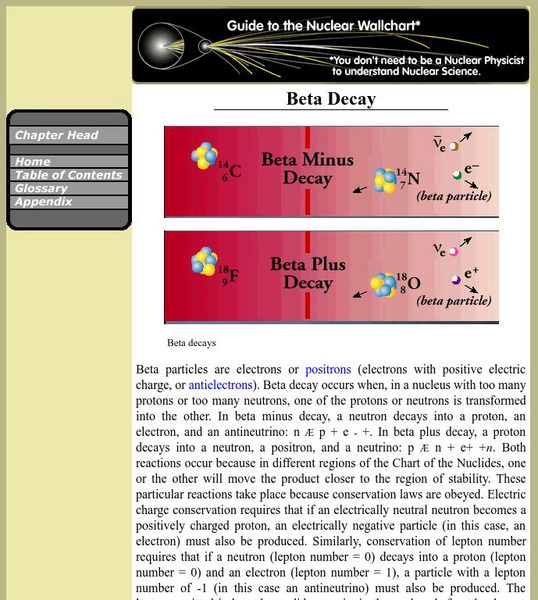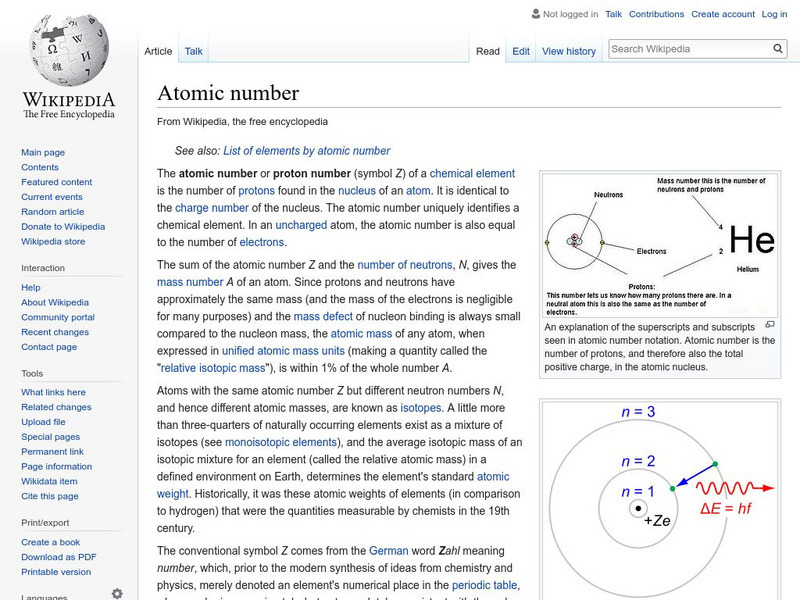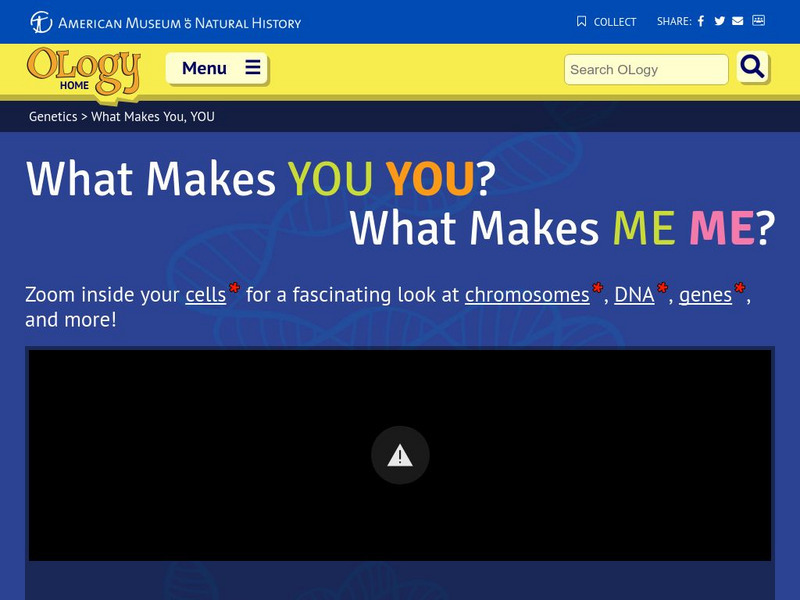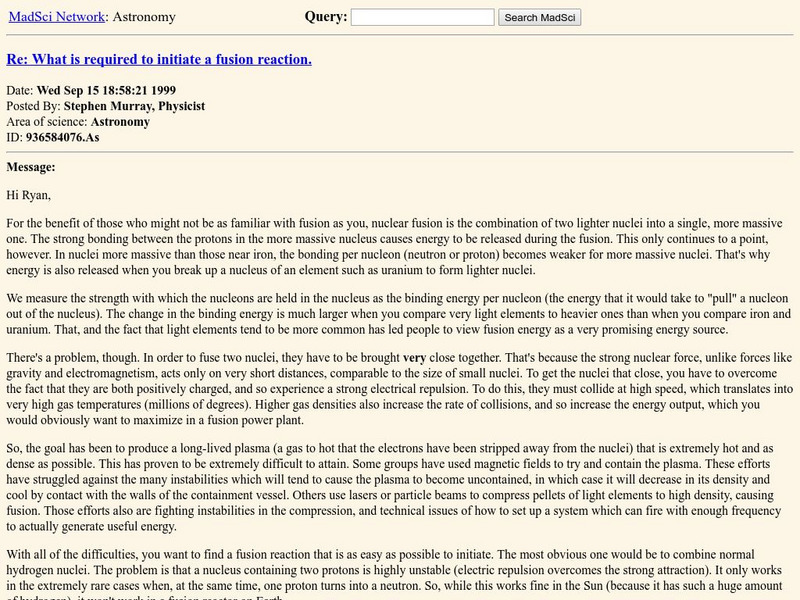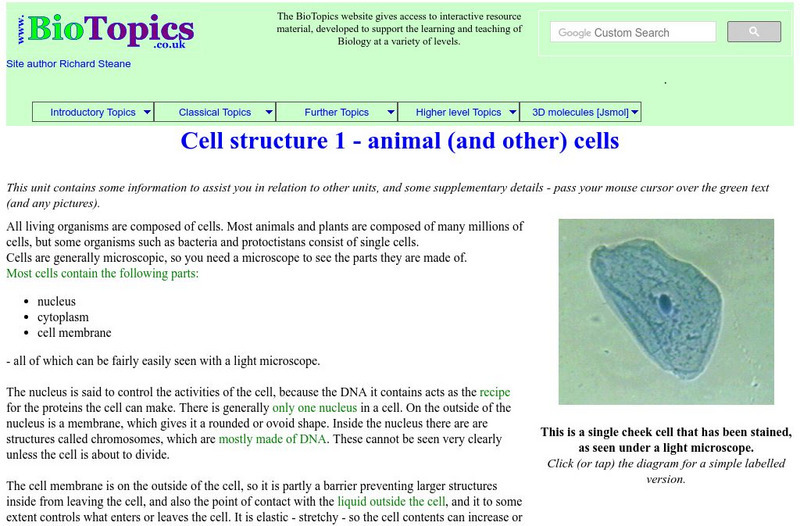Curated OER
Math:science Nucleus:identifying Bones of the Body (Lab)
A nice site which provides descriptions of each of the bones that make up our skeletal system. Then there is a lab activity for students to complete in which they build a skeletal system and describe the structure/function of each bone...
Encyclopedia Britannica
Encyclopedia Britannica: Hydrogen Ion
This brief entry describes the hydrogen ion, strictly, as the nucleus of a hydrogen atom separated from its accompanying electron. The hydrogen nucleus is made up of a particle carrying a unit positive electric charge, called a proton.
Lawrence Berkeley National Laboratory
Berkeley Lab: Beta Decay
Entry explores the process of beta decay which occurs when, in a nucleus with too many protons or too many neutrons, one of the protons or neutrons is transformed into the other.
Cosmo Learning
Cosmo Learning: Video: Mitosis in Real Time
Can you identify the steps of mitosis in this video? The video shows the process of the nucleus of a eukaryotic cell dividing in real time. [0:19]
Wikimedia
Wikipedia: Atomic Number
Wikipedia provides the definition of the term, "Atomic number," a term used in chemistry and physics to represent the number of protons in the nucleus of an atom.
Other
Atoms in Motion: Atoms and Ions
All matter is made of atoms! And atoms are made of even smaller more fundamental particles. Atoms are not shiny little rigid spheres as we depict in drawings and simulations; they're more like a squishy storm of tiny particles swirling...
Nobel Media AB
The Nobel Prize: Structure of Matter: Can Quarks Be Seen?
Learn about an experiment that allowed quarks to be seen within the nucleus! This reference page will help you understand how you can see a quark.
American Museum of Natural History
American Museum of Natural History: O Logy: What Makes You You? What Makes Me Me?
Simple animation explains the function of chromosomes, genes, and DNA by letting you zoom into a cell nucleus for a closer look.
MadSci Network
Msn: What Is Required to Initiate a Fusion Reaction?
From the Mad Scientist Network web site. Using a question and answer format, this page provides a thorough discussion of fusion reactions. Fusion and fission are compared and contrasted and the mechanisms which must occur to initiate and...
Lawrence Berkeley National Laboratory
Berkeley Lab: Alpha Decay
Using examples, this page defines and explains what happens in the process of alpha decay.
Lawrence Berkeley National Laboratory
Berkeley Lab: Gamma Decay
A brief explanation of the process of gamma decay is provided.
Lawrence Berkeley National Laboratory
Berkeley Lab: Other Symmetries
Brief exploration of approximate symmetries used to describe and predict the behavior of nuclei.
Lawrence Berkeley National Laboratory
Berkeley Lab: Nuclear Energy Levels
Brief explanation of nuclear energy levels whose location and properties are governed by the rules of quantum mechanics.
Lawrence Berkeley National Laboratory
Berkeley Lab: Basic Nuclear Science Information
Site provides the ABC's of nuclear science including radioactivity and gamma decay to fission and comic rays.
Wikimedia
Wikipedia: Atomic Radius
This site from the encyclopedia Wikipedia provides a basic definition for what the atomic radius is, and an explanation of what covalent and metallic radii are.
Thomas Jefferson National Accelerator Facility
Jefferson Lab: Beta Decay
This site from Jefferson Lab provides a description of beta decay along with two helpful formula examples. Several links are provided throughout this page for additional information on related subjects.
My Science Site
Neuroscience for Kids: Types of Neurons (Nerve Cells) [Pdf]
Site delves into what neurons are and what they do. Also contains colorful illustrations of neurons.
Cells Alive
Cells Alive:organelle Crossword #2
A crossword to help review the terms and definitions associated with organelles.
Sophia Learning
Sophia: Dna: Lesson 2
Explains how DNA contains genetic material and how it is housed in chromosomes. This lesson is 2 of 5 in the series titled "DNA."
Sophia Learning
Sophia: Dna: Lesson 1
Explains how DNA contains genetic material and how it is housed in chromosomes. This lesson is 1 of 5 in the series titled "DNA."
Sophia Learning
Sophia: Eukaryotic vs. Prokaryotic Cells: Lesson 1
This lesson explains the difference between Eukaryotic and Prokaryotic cells. It is 1 of 4 in the series titled "Eukaryotic vs. Prokaryotic Cells."
Sophia Learning
Sophia: James Chadwick
This lesson explains the discovery of the neutron and Chadwick's experimental process.
Bio Topics
Bio Topics: Cell Structure
A reference site exploring cell structure. Learn about the structures and functions of the major organelles of the cell. Also included are research questions to better understand the cell.
Bio Topics
Bio Topics: Cell Structure
An online worksheet exploring the cell structure and cell specialization. Worksheet includes diagramming and fill in the blank opportunities related to cell structure.
Other popular searches
- Cell Nucleus
- Atomic Nucleus
- Comet Nucleus
- Nucleus Dna Replication
- Nucleus of Cells
- The Nucleus
- Nucleus Radioactivity
- Condensation Nucleus
- Nucleus Discovery
- Chromatin Nucleus
- Nucleus and Human Body
- Nucleus Partners


